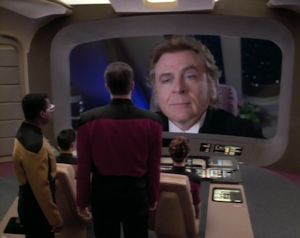| |||||||||||
| |||||||||||
|
Spoiler-free notes: I love how the episode starts with Moriarty all pissed that he's been apparently forgotten about for four years. Indeed, in four years, he's never even been mentioned on the show until now. The reason for this isn't that the writers were neglecting a loose thread from the second season--they loved the Sherlock Holmes stuff and deliberately left "Elementary, Dear Data" open-ended--but was actually because of a legal dispute between the estate of Sir Arthur Conan Doyle and Paramount. Apparently, the estate was mad about the film Young Sherlock Holmes, but after agreeing to a "reasonable" licensing fee, everything worked out in the end, allowing this episode to go forward. I'm actually kind of glad all these shenanigans happened behind the scenes, because the four year separation between these two episodes gives Moriarty plenty of motivation for his actions. It also allows the story to include Barclay, without whom this episode wouldn't have worked as well. There's a good skeptical undercurrent in this story, which is totally appropriate given that Sherlock Holmes is one of the great skeptical superheroes. Moriarty essentially performs a magic trick by walking out of the holodeck--doing what is completely impossible with no rational explanation. It is therefore up to Data, using Holmsian deductive reasoning, to figure out how he pulled it off. I like that this is a holodeck episode that doesn't involve a computer malfunction. The Countess keeps saying that the pattern enhancers will help both her and Moriarty to get off the holodeck, a subtle clue about what's really going on. There's also no establishing shots, no exterior views of the Enterprise drifting in space near the colliding planets, until we are taken back out into the "real world." I don't like the title, though. It kind of gives it all away. When Picard tells the simulated La Forge to excuse himself, he kind of sulks away, no doubt to sit in a corner, rocking back and forth as he questions the existential crisis he's in. Picard breaks the fourth wall at the end when he supposes that their reality might just be a simulation running on somebody's desk, but I'm actually watching it on my laptop, which is on my lap, not on my desk. I like to think that, one day, Moriarty figures out he's in a simulation but is powerless to do anything about it. I'm a sucker for layered reality stories like The Matrix, eXistenZ, Inception, etc., and this episode predates all of those (though it certainly isn't the first story to feature this narrative idea). As holodeck episodes go, this one is probably my favorite, and despite my greatest attempts to nitpick it, I can't find any cracks in the narrative. It's a beautifully consistent logic puzzle that doesn't break down upon multiple viewings. Though it doesn't reference Sherlock Holmes as much as "Elementary, Dear Data," it still honors Conan Doyle's creation in its thematic thrust without being overly blatant. It's good fun that plays around with the philosophical loose ends left behind by Moriarty's creation four years ago. The character of Moriarty is, in many ways, a precursor to Voyager's doctor. Indeed, with The Doctor learning how to move about with the help of a mobile holographic emitter, he accomplishes what Moriarty fails to. In retrospect, a mobile emitter seems like an obvious solution. | |||||||||||
|
| |||||||||||
| |||||||||||
|
Copyright ©2012 e. magill. All rights reserved.
|

